人教版(2019)选择性必修第一册Unit 4 Body Language Using Language Reading for Writing课件(共40张PPT)
文档属性
| 名称 | 人教版(2019)选择性必修第一册Unit 4 Body Language Using Language Reading for Writing课件(共40张PPT) | 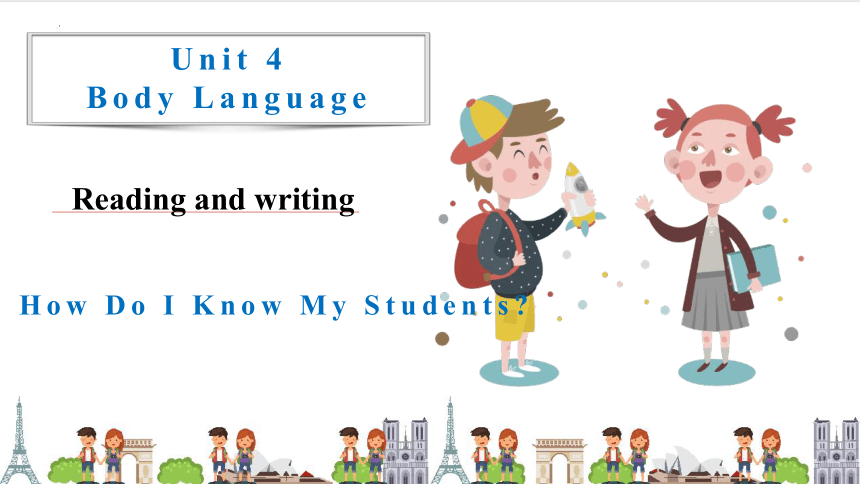 | |
| 格式 | pptx | ||
| 文件大小 | 15.8MB | ||
| 资源类型 | 教案 | ||
| 版本资源 | 人教版(2019) | ||
| 科目 | 英语 | ||
| 更新时间 | 2024-09-06 19:44:20 | ||
图片预览

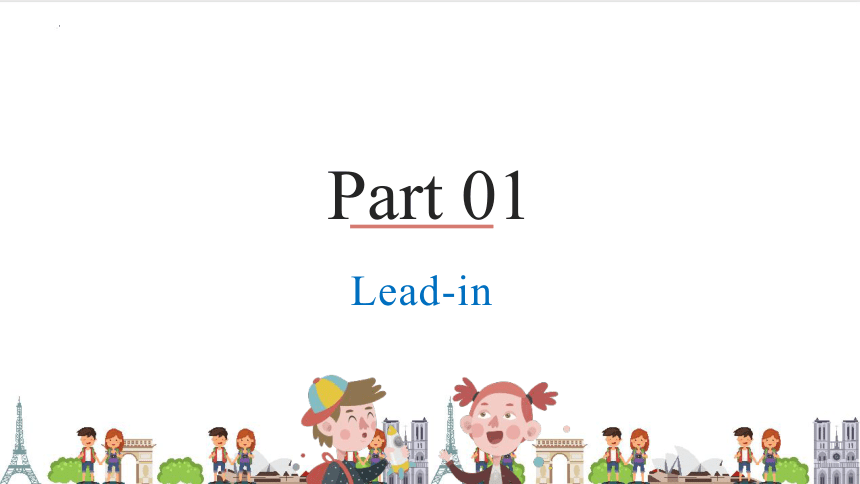
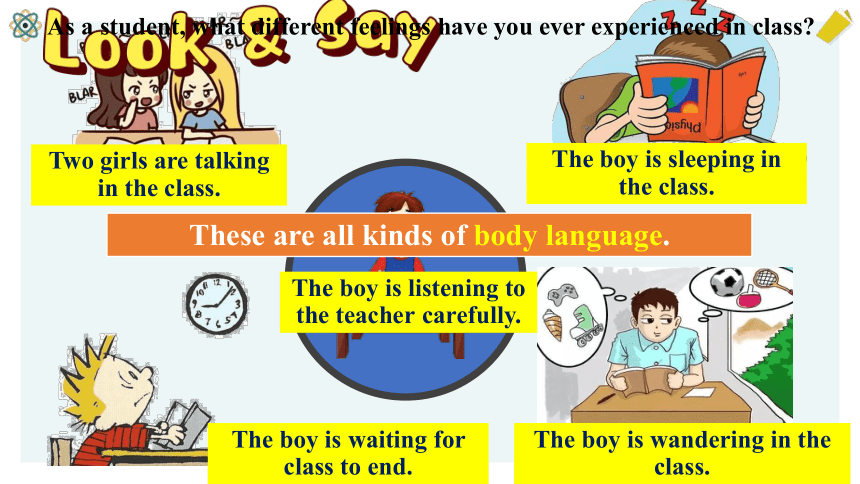
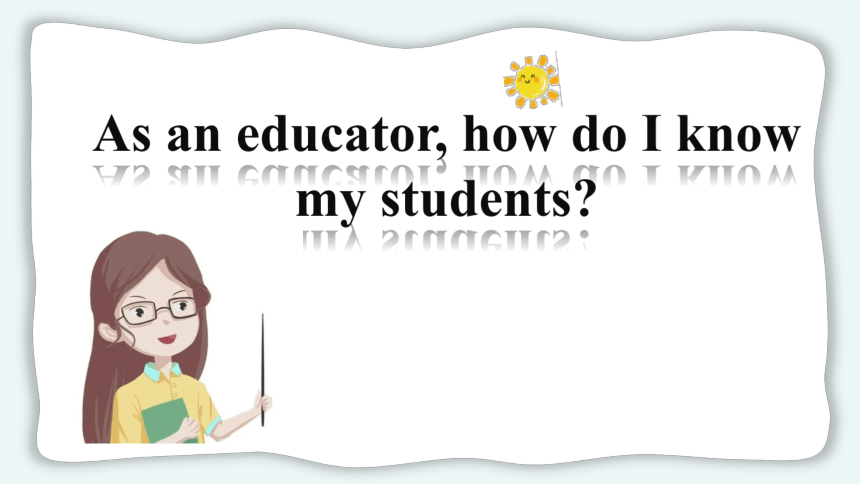
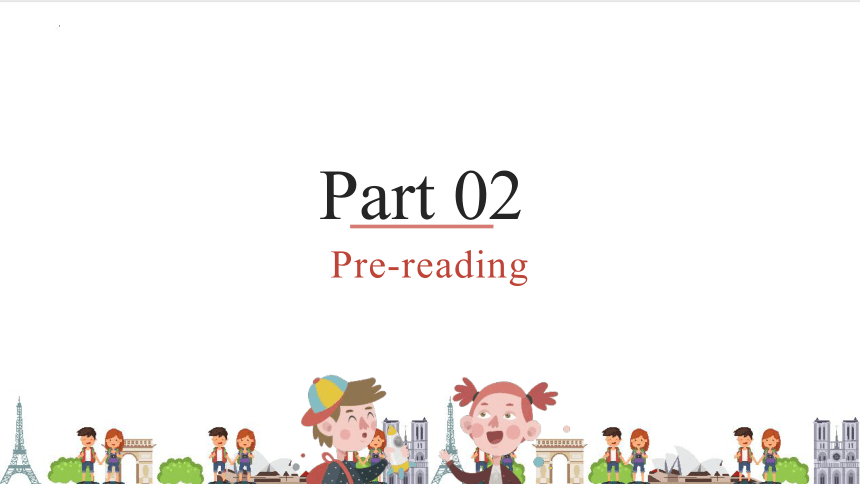
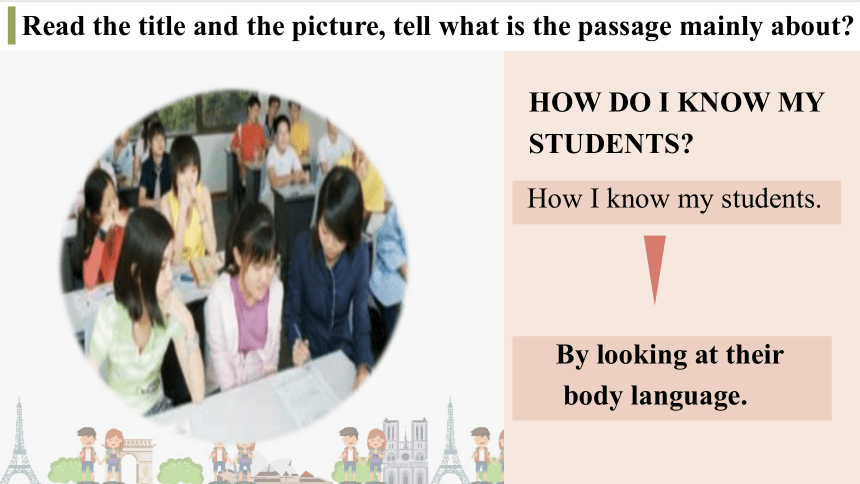
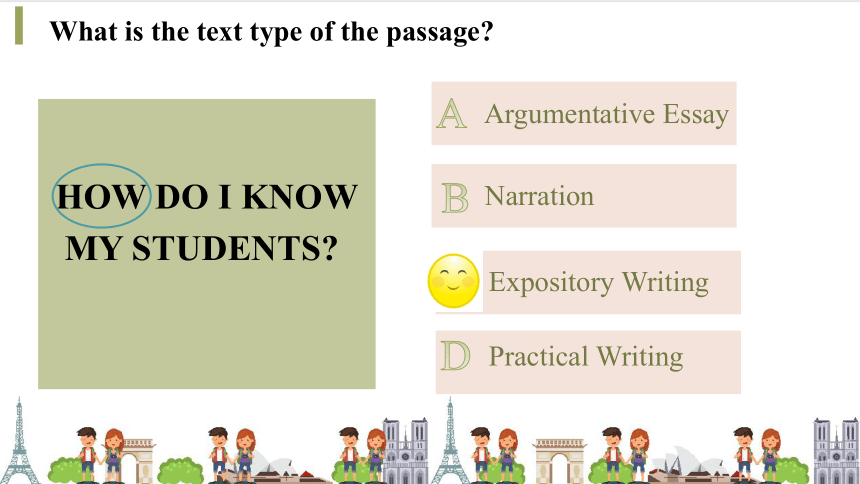
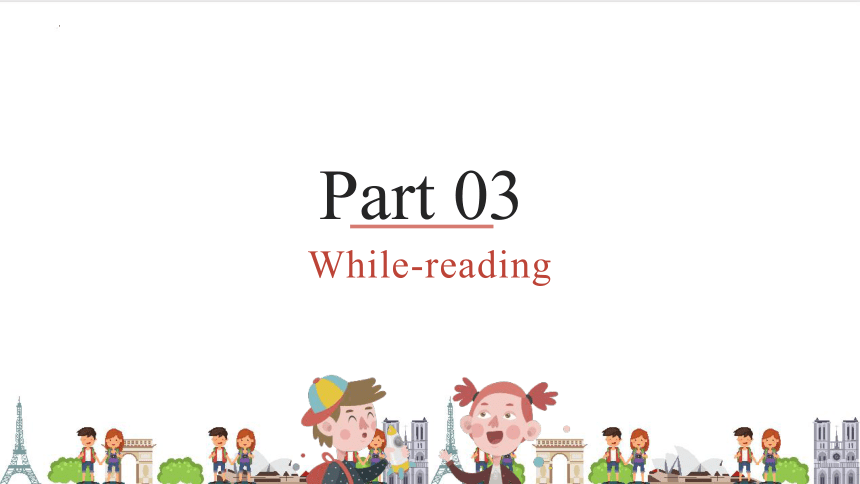
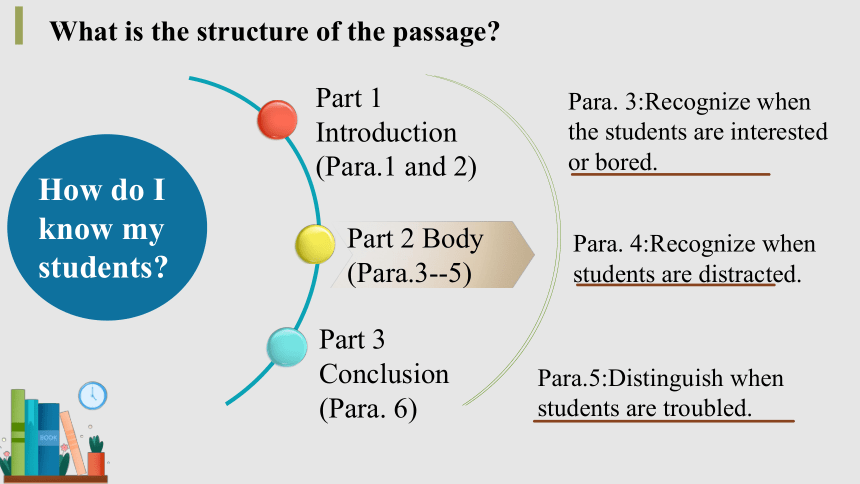

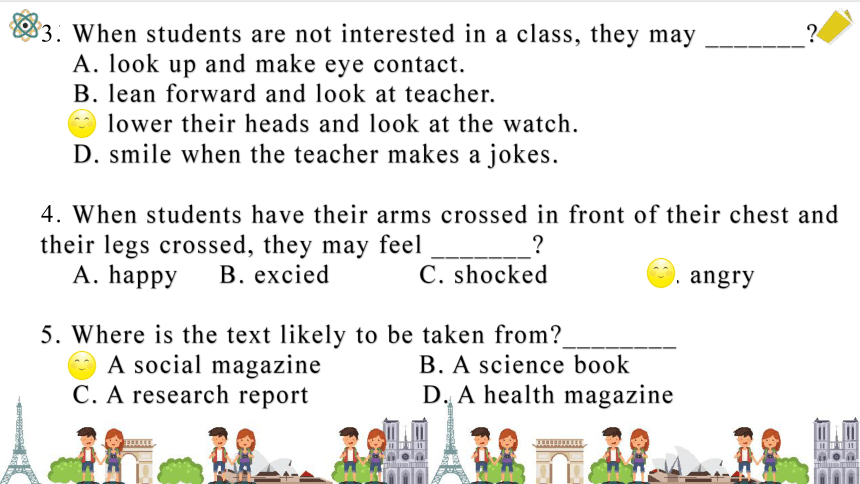
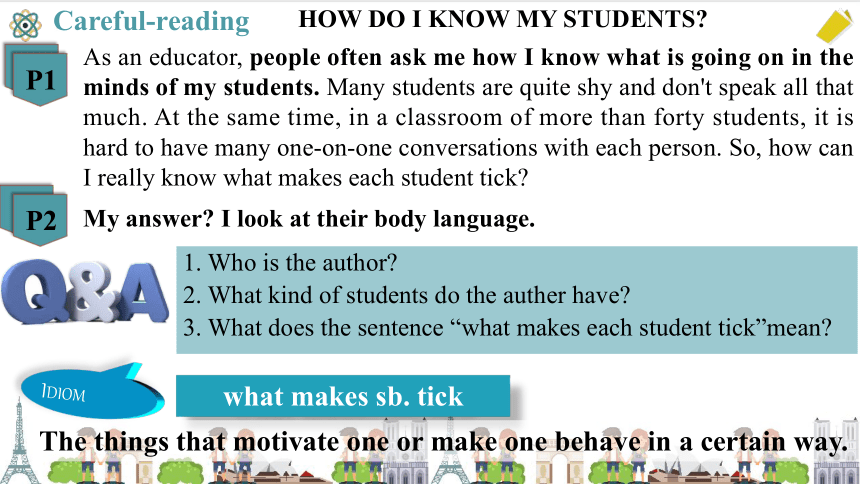
文档简介
(共40张PPT)
Unit 4
Body Language
How Do I Know My Students
Reading and writing
Lead-in
Part 01
Two girls are talking in the class.
The boy is sleeping in the class.
The boy is waiting for class to end.
The boy is wandering in the class.
The boy is listening to the teacher carefully.
These are all kinds of body language.
As a student, what different feelings have you ever experienced in class
As an educator, how do I know my students
Pre-reading
Part 02
Read for the text structure
HOW DO I KNOW MY STUDENTS
Read the title and the picture, tell what is the passage mainly about
How I know my students.
By looking at their
body language.
Read for the text structure
HOW DO I KNOW
MY STUDENTS
What is the text type of the passage
Narration
B
Argumentative Essay
A
Practical Writing
D
Expository Writing
C
While-reading
Part 03
How do I know my students
Part 1 Introduction
(Para.1 and 2)
Part 2 Body
(Para.3--5)
Part 3 Conclusion
(Para. 6)
Para. 3:Recognize when the students are interested or bored.
Para. 4:Recognize when students are distracted.
Para.5:Distinguish when students are troubled.
What is the structure of the passage
Skimming
1. What is the main idea of the text
A. Different kinds of classroom body language.
B. How to know the students’ classroom performance through their body language.
C. The importance of knowing about classroom body language as an educator.
D. How to read the students’ minds in class through their body language.
2. How can the writer know what makes each student tick
A. By having one-on-one conversations with each person.
B. By talking with some students.
C. By observing students’ body language.
D. By asking them to write a letter to the teacher.
3. When students are not interested in a class, they may _______
A. look up and make eye contact.
B. lean forward and look at teacher.
C. lower their heads and look at the watch.
D. smile when the teacher makes a jokes.
4. When students have their arms crossed in front of their chest and their legs crossed, they may feel _______
A. happy B. excied C. shocked D. angry
5. Where is the text likely to be taken from ________
A. A social magazine B. A science book
C. A research report D. A health magazine
As an educator, people often ask me how I know what is going on in the minds of my students. Many students are quite shy and don't speak all that much. At the same time, in a classroom of more than forty students, it is hard to have many one-on-one conversations with each person. So, how can I really know what makes each student tick
My answer I look at their body language.
Idiom
what makes sb. tick
The things that motivate one or make one behave in a certain way.
1. Who is the author
2. What kind of students do the auther have
3. What does the sentence “what makes each student tick”mean
Careful-reading
P1
P2
HOW DO I KNOW MY STUDENTS
It is easy to recognise when students are interested in a lesson. Most tend to look up and make eye contact. When I make a joke, they smile. When I talk about something difficult, they look confused. I know when students are really interested, however, because they lean forward and look at me. People have a tendency to lean towards whatever they are interested in. So if a student has his head lowered to look at his watch, it implies he is bored and just counting the minutes for the class to end. If two friends are leaning their heads together, they are probably writing notes to each other. Of course, not everyone who looks up is paying attention in class. Some students look up, but there is an absence of eye contact. Their eyes barely move, and they always have the same distant expression on their faces. It is as though they are asleep with their eyes open.
1. Topic sentence.
2. Body language &implication.
P3
When students are interested:
look up and make eye contact
lean forward and look at me
When students are bored
have their head lower to look at their watch.
lean their heads together.
look up without eye contact and have the same distant expression on their face.
P4
Some students are amused by something else. They spend all their time looking anywhere but at me. Then again, some students' favourite activity is daydreaming. With their chins on their hands, they occupy themselves by staring out of the window or up at the ceiling. They are certainly interested in something, but who knows what. The main thing is reminding distracted students that they need to pay attention in class.
1. Topic sentence.
2. Body language &implication.
P5
1. Topic sentence.
2. Body language &implication.
While it is easy to perceive when students are interested, bored, or distracted, it is sometimes much harder to distinguish when students are troubled. Students who are angry, afraid, or experiencing anxiety may have their arms crossed in front of the chests and their legs closed or closed, like they are guarding their bodies. Students who are sad or worried will nearly always wear a frown. They may also hide their faces in their hands like they are embarrassed or ashamed. Some students act this way merely because they are afraid of being called on by the teacher. However, if a student does not bother to brush her hair and her eyes are red from weeping, then I can infer that there are deeper issues at work. It could be that she is having serious conflicts with other students or at home. Whatever it is, I know I need to inquire and assess what is going on.
When students have their arms crossed in front of their chests and their legs closed and crossed.
angry
afraid
anxious
distinguish when studenrs are troubled
frown
sad
worried
hide their faces in their hands
sad or worried
embarrassed or ashamed
afraid of being called by the teacher.
eyes are red from weeping
deeper issues like having conflicts with others.
different feelings
interested
confused
distant
distracted
angry
anxious
…
P3-P5
How many feelings are mentioned in this part What are they
amused
bored
Careful-reading
Ultimately, my duty is helping every student learn. Their body language lets me know when to adjust class activities, when to intervene, and when to talk to students individually, so they can all get the most out of school. Reacting to body language is an important component of being a teacher.
P6
Why does the teacher think body language is important
Post-reading
Part 04
单击此处添加标题
Match the body language with the meanings.
___ 1 Looking up and making eye contact ___ 2 Leaning over to look at one’s watch ___ 3 Two friends leaning heads together ___ 4 Leaning forward and looking at the teacher ___ 5 Looking up, but no eye contact, no expression ___ 6 Looking away ___ 7 Chin on hand, looking out the window ___ 8 Looking down, arms or legs crossed ___ 9 Frowning ___ 10 Hair not brushed, red eyes A very interested
B bored
C interested
D sad or worried
E distracted
F writing notes
G serious problems
H like they are asleep
I daydreaming
J angry, afraid, or experiencing anxiety
C
B
F
A
H
E
I
D
J
G
True and Flase
( )1. It is not easy to recognise when students are interested in a lesson.
( ) 2. If a student has his head lowered to look at his watch, it implies he is bored.
( ) 3. Some students are amused by something else because they spend all their time looking anywhere but at me.
( ) 4. Students who are angry, afraid, or experiencing anxiety will nearly always wear a frown.
( ) 5. Reacting to body language is very important for a teacher.
F
T
T
F
T
Look at the following photos. In groups, discuss what these people are doing and what their body language is telling you.
The teacher is _____________a boy student, who looks __________.
He is perhaps ________________________________.
Meanwhile, the girl sitting beside is _________with one hand ___________________. Perhaps she is _________to see the boy___________________________________.
pointing at
serious
asking the boy to answer a question
smiling
covering her mouth
amused
is being asked such a difficult qustion
The boy is ____________ or _________ his fist with a smile to show his ____________ or ___________ to achieve a goal or task.
raising
shaking
determination
confidence
The boy is leaning over and _________ something interesting to the girl in her ear.
The girl is listening to it with so much enjoyment as to __________ her mouth with both her ________ to avoid giving a loud laugh.
whisper
cover
hands
Test for goals
1. Why does the author ask the question in para.1
A. To tell us the author is an educator.
B. To explain why the author’s students are shy
C. To introduce the topic
D. To show body language is important
2. What is the structure of the passage
A. 总-分 B. 总-分-总 C.分-分-总 D.总-分-分
3. How is the passage developed
A. by listing numbers B. by making comparison
C. by observation D. by giving examples
As a teacher, I try to know 1. each student is thinking by watching their body language. Recognizing whether students are 2.__________(interest) in a lesson is easy. Most students tend to look up and make eye contact and sometimes they lean forward and look at me. If a student looks 3. at his watch, it implies he is bored.If two friends are leaning their heads together,they are 4.___________(probable) writing notes to each other. Some students are easy to be 5. (distract).Instead of looking at me, they spend all their time looking anywhere.Then again, some students prefer daydreaming. 6. their chins on their hands, they occupy 7._____________(them) by staring out of the window or up at the ceiling. In these cases, they should be reminded to concentrate.
Distinguishing when students are troubled is much 8.__________ (hard). If students have their arms crossed in front of their chests and their legs 9.________(close) or crossed, it shows they are angry, afraid, or experiencing anxiety.
Finally, it is my duty to help every student to learn and I adjust class 10._____ (activity) according to their body language.In my opinion,reacting to body language is an important component of being a teacher.
what
interested
down
probably
distracted
With
themselves
harder
closed
activities
writing
假如你是李华,你的英国朋友Tom将来中国旅游,发邮件向你询问中英日常生活肢体语言的异同。请你回复邮件,内容包括:
1. 表示欢迎;
2. 不同点:在中国,与长辈交谈时,低头避免直视等;
3. 相似点:见面握手,微笑等。
布局谋篇
第一步:审题
时态:根据提示,时态应为____________和_____________。
结构:___________
人称:________________
重点:______________________________
一般现在时
一般将来时
总分总
第一、二人称
中英日常生活肢体语言的异同
第一段:____________________
第二段:____________________
第三段:____________________
得知信息+写作目的
具体介绍中英肢体语言的异同
表达期待
第二步:写作框架
【词汇储备】
表达我最热烈的欢迎_______________________________
肢体语言_____________________
…和…有差异_________________________
和某人交谈___________________________
一方面….另一方面______________________________
避免眼神交流_________________________
老人___________ 尊敬__________
姿势__________ 握手_______________
微笑___________ 点头_______________
express my warmest welcome
body language
vary from…to…
talk to someone
the elderly
avoid making eye contact
respect
gestures
On the one hand…, on the other hand
shake hands
smile
nod the head
【连词成句】
1. 最近过得怎么样?____________________________________
2. 1)听说你要来中国旅行, 我写信是想表达我最热烈的欢迎。
Hearing that _____________________________________, I’m writing to_____________________________.
2) 很高兴收到的来信。在信中你问我关于中英肢体语言的差异,我写信你要告诉你一些它的事情。
I’m more than delighted to have received your letter, in which____________
________________________________________________________________ . I’m writing to ____________________________.
How is everything going
you are coming to China for travelling
express my warmest welcome
you asked
me about the differences of body langaue between Britain and china
tell you something about it
3. 更多细节如下。_________________________________
4. 众所周知,文化之间是存在肢体语言的差异的。
_________________, body language varies from culture to culture.
5. 例如,在中国当我们和长辈说话时,我们通常会低头避免眼神接触,这是一种尊敬的象征。
_______________, when______________________, we usually look down to avoid eye contact as a sign of respect.
6. 另外,和你们的文化不同,中国人在交流时站得更近。
_________ , different from your culture, ________________________
____________________
More details are as follows.
As we all know
For example
talking to the elderly
Besides
Chinese tend to stay closer
while talking.
7. 当然,当涉及到问候时,我们也有一些相同的姿势。
_________, when it comes to greeting we have the same gestures.
8. 像英国人一样,我们通常通过微笑、握手、点头来问候别人。
Like Britians, we _________________________________________
_________________
9. 很难在这里列出你想知道的一切, 所以我下载了一篇介绍这个话题的文章。
_____________all that you want to know here, so I downloaded a passage ___________the topic.
Of course
usually greet others by shaking hands, smiling or
nodding the head.
It’s hard to list
introducing
10. 我建议你可以读一下,它可以让你了解更多关于中国的习俗和文化。
I suggest you ___________it, ______________________________
________________________________.
11. 希望我的介绍对你有用。
__________________________________________________.
12. 期待着你的到来。
______________________________________________
should read
which can help you know more about
Chinese customs and cultures
I sincerely hope my introduction will be of great use to you
I’m looking forward to your coming.
佳作赏析
Dear Tom,
How is everything going I’m more than delighted to know that you will come to China for travelling. Besides, you asked me about the differences of body language between Britain and China. I’m writing to tell you something about it.
As we all know, body language varies from culture to culture. For instance, when talking to the elderly in China, we usually look down to avoid eye contact as a sign of respect. Besides, different from your culture, Chinese tend to stay closer while talking. Of course, some gestures have the same meaning. We favor shaking hands, smiling or nodding the head to greet someone, just as you do.
I deeply hope my introduction can be of great help to you. And I’m looking forward to you coming.
THANKS!
Unit 4
Body Language
How Do I Know My Students
Reading and writing
Lead-in
Part 01
Two girls are talking in the class.
The boy is sleeping in the class.
The boy is waiting for class to end.
The boy is wandering in the class.
The boy is listening to the teacher carefully.
These are all kinds of body language.
As a student, what different feelings have you ever experienced in class
As an educator, how do I know my students
Pre-reading
Part 02
Read for the text structure
HOW DO I KNOW MY STUDENTS
Read the title and the picture, tell what is the passage mainly about
How I know my students.
By looking at their
body language.
Read for the text structure
HOW DO I KNOW
MY STUDENTS
What is the text type of the passage
Narration
B
Argumentative Essay
A
Practical Writing
D
Expository Writing
C
While-reading
Part 03
How do I know my students
Part 1 Introduction
(Para.1 and 2)
Part 2 Body
(Para.3--5)
Part 3 Conclusion
(Para. 6)
Para. 3:Recognize when the students are interested or bored.
Para. 4:Recognize when students are distracted.
Para.5:Distinguish when students are troubled.
What is the structure of the passage
Skimming
1. What is the main idea of the text
A. Different kinds of classroom body language.
B. How to know the students’ classroom performance through their body language.
C. The importance of knowing about classroom body language as an educator.
D. How to read the students’ minds in class through their body language.
2. How can the writer know what makes each student tick
A. By having one-on-one conversations with each person.
B. By talking with some students.
C. By observing students’ body language.
D. By asking them to write a letter to the teacher.
3. When students are not interested in a class, they may _______
A. look up and make eye contact.
B. lean forward and look at teacher.
C. lower their heads and look at the watch.
D. smile when the teacher makes a jokes.
4. When students have their arms crossed in front of their chest and their legs crossed, they may feel _______
A. happy B. excied C. shocked D. angry
5. Where is the text likely to be taken from ________
A. A social magazine B. A science book
C. A research report D. A health magazine
As an educator, people often ask me how I know what is going on in the minds of my students. Many students are quite shy and don't speak all that much. At the same time, in a classroom of more than forty students, it is hard to have many one-on-one conversations with each person. So, how can I really know what makes each student tick
My answer I look at their body language.
Idiom
what makes sb. tick
The things that motivate one or make one behave in a certain way.
1. Who is the author
2. What kind of students do the auther have
3. What does the sentence “what makes each student tick”mean
Careful-reading
P1
P2
HOW DO I KNOW MY STUDENTS
It is easy to recognise when students are interested in a lesson. Most tend to look up and make eye contact. When I make a joke, they smile. When I talk about something difficult, they look confused. I know when students are really interested, however, because they lean forward and look at me. People have a tendency to lean towards whatever they are interested in. So if a student has his head lowered to look at his watch, it implies he is bored and just counting the minutes for the class to end. If two friends are leaning their heads together, they are probably writing notes to each other. Of course, not everyone who looks up is paying attention in class. Some students look up, but there is an absence of eye contact. Their eyes barely move, and they always have the same distant expression on their faces. It is as though they are asleep with their eyes open.
1. Topic sentence.
2. Body language &implication.
P3
When students are interested:
look up and make eye contact
lean forward and look at me
When students are bored
have their head lower to look at their watch.
lean their heads together.
look up without eye contact and have the same distant expression on their face.
P4
Some students are amused by something else. They spend all their time looking anywhere but at me. Then again, some students' favourite activity is daydreaming. With their chins on their hands, they occupy themselves by staring out of the window or up at the ceiling. They are certainly interested in something, but who knows what. The main thing is reminding distracted students that they need to pay attention in class.
1. Topic sentence.
2. Body language &implication.
P5
1. Topic sentence.
2. Body language &implication.
While it is easy to perceive when students are interested, bored, or distracted, it is sometimes much harder to distinguish when students are troubled. Students who are angry, afraid, or experiencing anxiety may have their arms crossed in front of the chests and their legs closed or closed, like they are guarding their bodies. Students who are sad or worried will nearly always wear a frown. They may also hide their faces in their hands like they are embarrassed or ashamed. Some students act this way merely because they are afraid of being called on by the teacher. However, if a student does not bother to brush her hair and her eyes are red from weeping, then I can infer that there are deeper issues at work. It could be that she is having serious conflicts with other students or at home. Whatever it is, I know I need to inquire and assess what is going on.
When students have their arms crossed in front of their chests and their legs closed and crossed.
angry
afraid
anxious
distinguish when studenrs are troubled
frown
sad
worried
hide their faces in their hands
sad or worried
embarrassed or ashamed
afraid of being called by the teacher.
eyes are red from weeping
deeper issues like having conflicts with others.
different feelings
interested
confused
distant
distracted
angry
anxious
…
P3-P5
How many feelings are mentioned in this part What are they
amused
bored
Careful-reading
Ultimately, my duty is helping every student learn. Their body language lets me know when to adjust class activities, when to intervene, and when to talk to students individually, so they can all get the most out of school. Reacting to body language is an important component of being a teacher.
P6
Why does the teacher think body language is important
Post-reading
Part 04
单击此处添加标题
Match the body language with the meanings.
___ 1 Looking up and making eye contact ___ 2 Leaning over to look at one’s watch ___ 3 Two friends leaning heads together ___ 4 Leaning forward and looking at the teacher ___ 5 Looking up, but no eye contact, no expression ___ 6 Looking away ___ 7 Chin on hand, looking out the window ___ 8 Looking down, arms or legs crossed ___ 9 Frowning ___ 10 Hair not brushed, red eyes A very interested
B bored
C interested
D sad or worried
E distracted
F writing notes
G serious problems
H like they are asleep
I daydreaming
J angry, afraid, or experiencing anxiety
C
B
F
A
H
E
I
D
J
G
True and Flase
( )1. It is not easy to recognise when students are interested in a lesson.
( ) 2. If a student has his head lowered to look at his watch, it implies he is bored.
( ) 3. Some students are amused by something else because they spend all their time looking anywhere but at me.
( ) 4. Students who are angry, afraid, or experiencing anxiety will nearly always wear a frown.
( ) 5. Reacting to body language is very important for a teacher.
F
T
T
F
T
Look at the following photos. In groups, discuss what these people are doing and what their body language is telling you.
The teacher is _____________a boy student, who looks __________.
He is perhaps ________________________________.
Meanwhile, the girl sitting beside is _________with one hand ___________________. Perhaps she is _________to see the boy___________________________________.
pointing at
serious
asking the boy to answer a question
smiling
covering her mouth
amused
is being asked such a difficult qustion
The boy is ____________ or _________ his fist with a smile to show his ____________ or ___________ to achieve a goal or task.
raising
shaking
determination
confidence
The boy is leaning over and _________ something interesting to the girl in her ear.
The girl is listening to it with so much enjoyment as to __________ her mouth with both her ________ to avoid giving a loud laugh.
whisper
cover
hands
Test for goals
1. Why does the author ask the question in para.1
A. To tell us the author is an educator.
B. To explain why the author’s students are shy
C. To introduce the topic
D. To show body language is important
2. What is the structure of the passage
A. 总-分 B. 总-分-总 C.分-分-总 D.总-分-分
3. How is the passage developed
A. by listing numbers B. by making comparison
C. by observation D. by giving examples
As a teacher, I try to know 1. each student is thinking by watching their body language. Recognizing whether students are 2.__________(interest) in a lesson is easy. Most students tend to look up and make eye contact and sometimes they lean forward and look at me. If a student looks 3. at his watch, it implies he is bored.If two friends are leaning their heads together,they are 4.___________(probable) writing notes to each other. Some students are easy to be 5. (distract).Instead of looking at me, they spend all their time looking anywhere.Then again, some students prefer daydreaming. 6. their chins on their hands, they occupy 7._____________(them) by staring out of the window or up at the ceiling. In these cases, they should be reminded to concentrate.
Distinguishing when students are troubled is much 8.__________ (hard). If students have their arms crossed in front of their chests and their legs 9.________(close) or crossed, it shows they are angry, afraid, or experiencing anxiety.
Finally, it is my duty to help every student to learn and I adjust class 10._____ (activity) according to their body language.In my opinion,reacting to body language is an important component of being a teacher.
what
interested
down
probably
distracted
With
themselves
harder
closed
activities
writing
假如你是李华,你的英国朋友Tom将来中国旅游,发邮件向你询问中英日常生活肢体语言的异同。请你回复邮件,内容包括:
1. 表示欢迎;
2. 不同点:在中国,与长辈交谈时,低头避免直视等;
3. 相似点:见面握手,微笑等。
布局谋篇
第一步:审题
时态:根据提示,时态应为____________和_____________。
结构:___________
人称:________________
重点:______________________________
一般现在时
一般将来时
总分总
第一、二人称
中英日常生活肢体语言的异同
第一段:____________________
第二段:____________________
第三段:____________________
得知信息+写作目的
具体介绍中英肢体语言的异同
表达期待
第二步:写作框架
【词汇储备】
表达我最热烈的欢迎_______________________________
肢体语言_____________________
…和…有差异_________________________
和某人交谈___________________________
一方面….另一方面______________________________
避免眼神交流_________________________
老人___________ 尊敬__________
姿势__________ 握手_______________
微笑___________ 点头_______________
express my warmest welcome
body language
vary from…to…
talk to someone
the elderly
avoid making eye contact
respect
gestures
On the one hand…, on the other hand
shake hands
smile
nod the head
【连词成句】
1. 最近过得怎么样?____________________________________
2. 1)听说你要来中国旅行, 我写信是想表达我最热烈的欢迎。
Hearing that _____________________________________, I’m writing to_____________________________.
2) 很高兴收到的来信。在信中你问我关于中英肢体语言的差异,我写信你要告诉你一些它的事情。
I’m more than delighted to have received your letter, in which____________
________________________________________________________________ . I’m writing to ____________________________.
How is everything going
you are coming to China for travelling
express my warmest welcome
you asked
me about the differences of body langaue between Britain and china
tell you something about it
3. 更多细节如下。_________________________________
4. 众所周知,文化之间是存在肢体语言的差异的。
_________________, body language varies from culture to culture.
5. 例如,在中国当我们和长辈说话时,我们通常会低头避免眼神接触,这是一种尊敬的象征。
_______________, when______________________, we usually look down to avoid eye contact as a sign of respect.
6. 另外,和你们的文化不同,中国人在交流时站得更近。
_________ , different from your culture, ________________________
____________________
More details are as follows.
As we all know
For example
talking to the elderly
Besides
Chinese tend to stay closer
while talking.
7. 当然,当涉及到问候时,我们也有一些相同的姿势。
_________, when it comes to greeting we have the same gestures.
8. 像英国人一样,我们通常通过微笑、握手、点头来问候别人。
Like Britians, we _________________________________________
_________________
9. 很难在这里列出你想知道的一切, 所以我下载了一篇介绍这个话题的文章。
_____________all that you want to know here, so I downloaded a passage ___________the topic.
Of course
usually greet others by shaking hands, smiling or
nodding the head.
It’s hard to list
introducing
10. 我建议你可以读一下,它可以让你了解更多关于中国的习俗和文化。
I suggest you ___________it, ______________________________
________________________________.
11. 希望我的介绍对你有用。
__________________________________________________.
12. 期待着你的到来。
______________________________________________
should read
which can help you know more about
Chinese customs and cultures
I sincerely hope my introduction will be of great use to you
I’m looking forward to your coming.
佳作赏析
Dear Tom,
How is everything going I’m more than delighted to know that you will come to China for travelling. Besides, you asked me about the differences of body language between Britain and China. I’m writing to tell you something about it.
As we all know, body language varies from culture to culture. For instance, when talking to the elderly in China, we usually look down to avoid eye contact as a sign of respect. Besides, different from your culture, Chinese tend to stay closer while talking. Of course, some gestures have the same meaning. We favor shaking hands, smiling or nodding the head to greet someone, just as you do.
I deeply hope my introduction can be of great help to you. And I’m looking forward to you coming.
THANKS!
